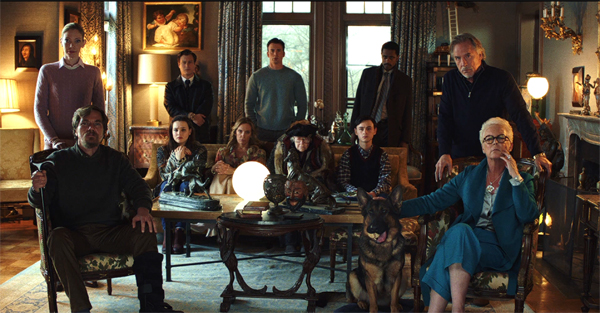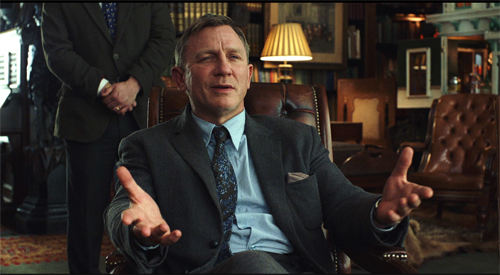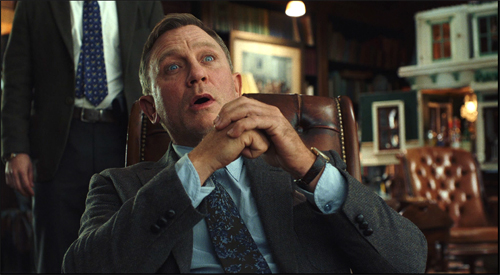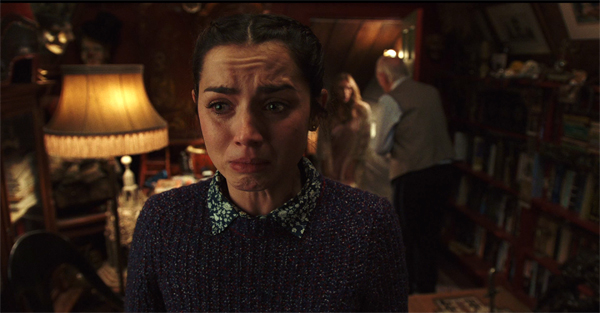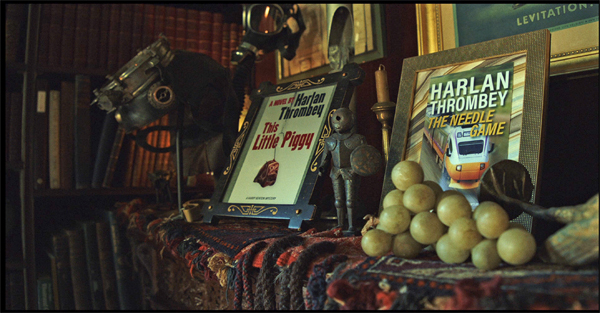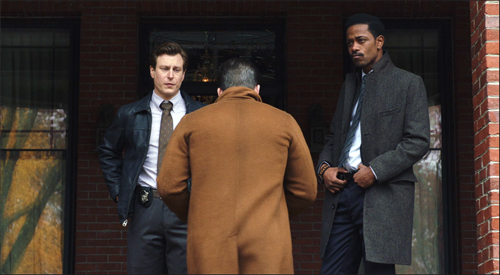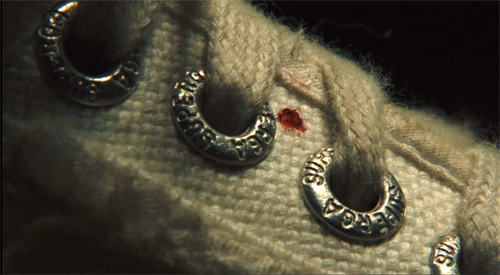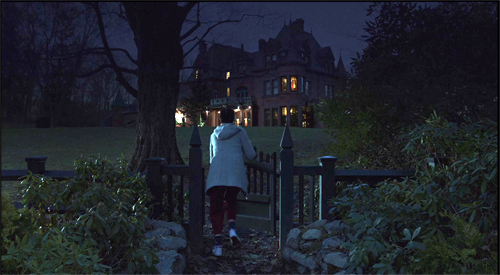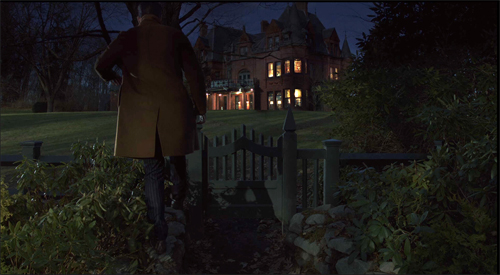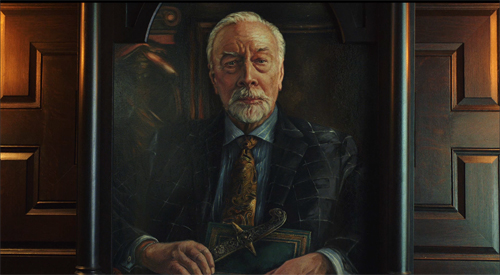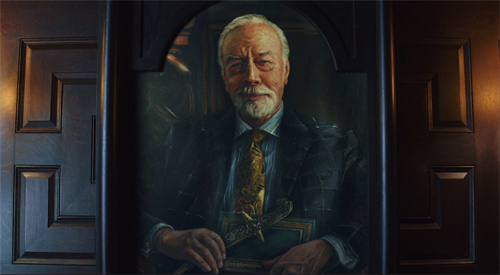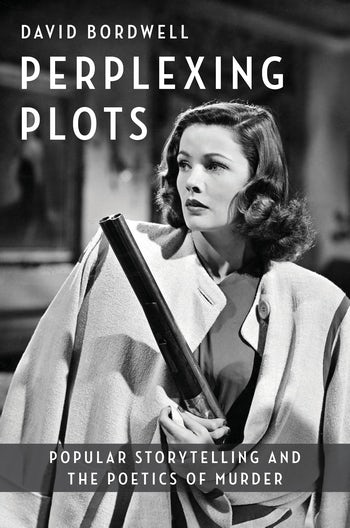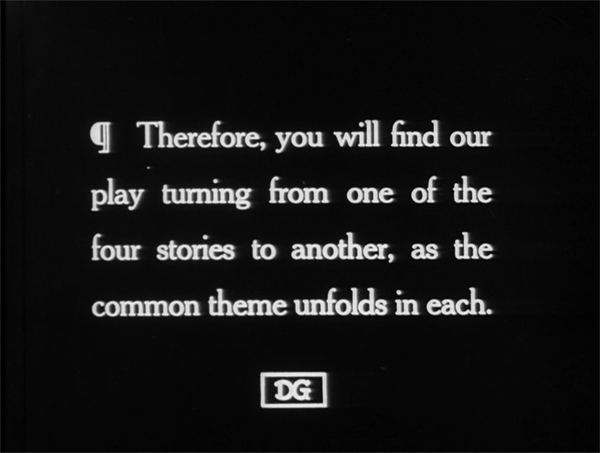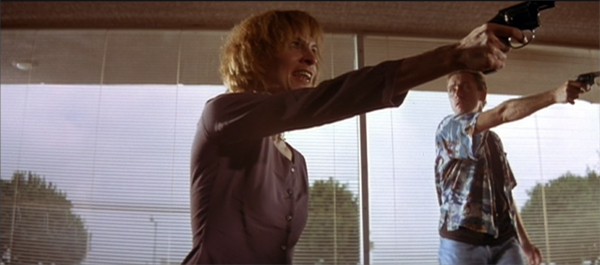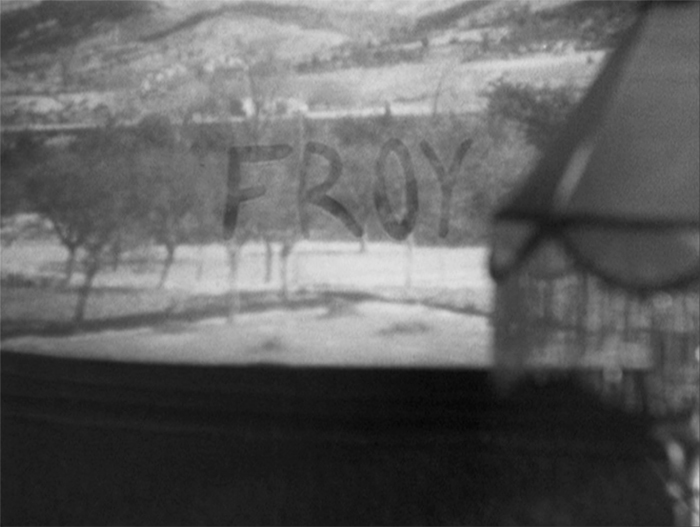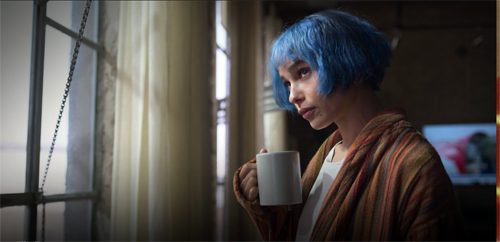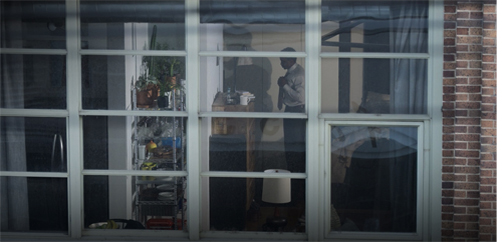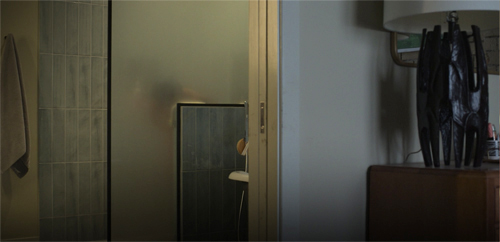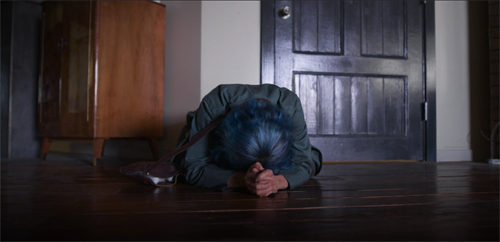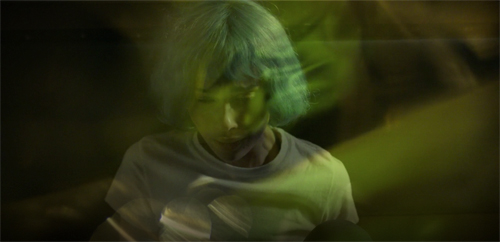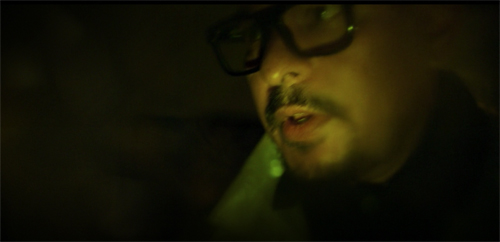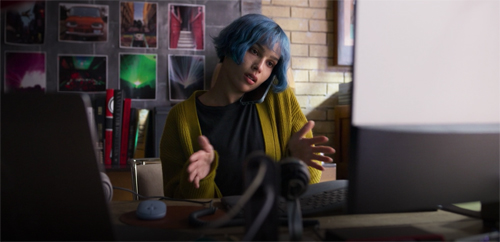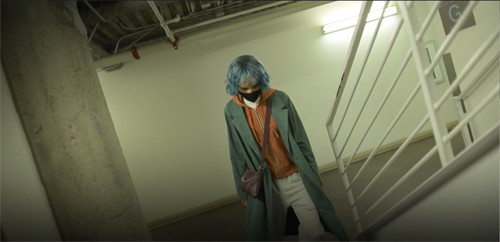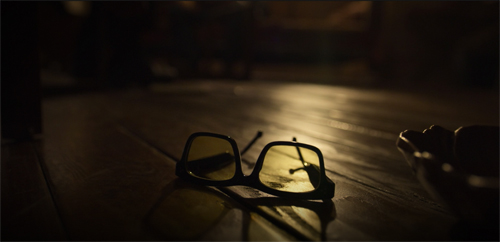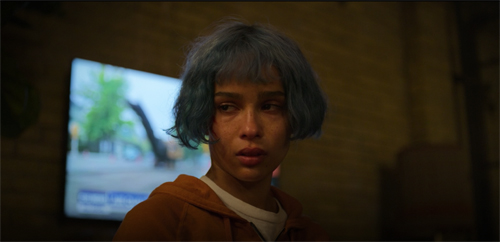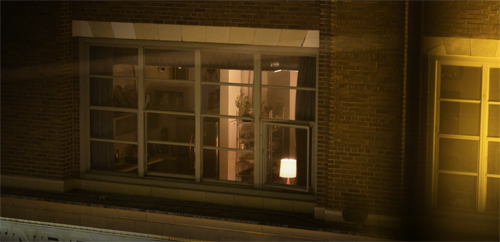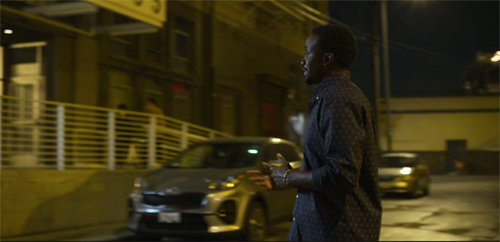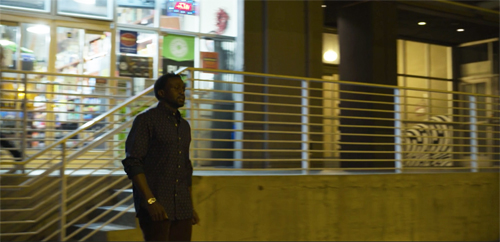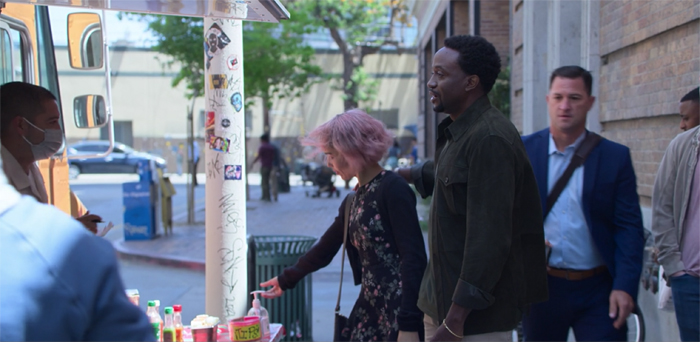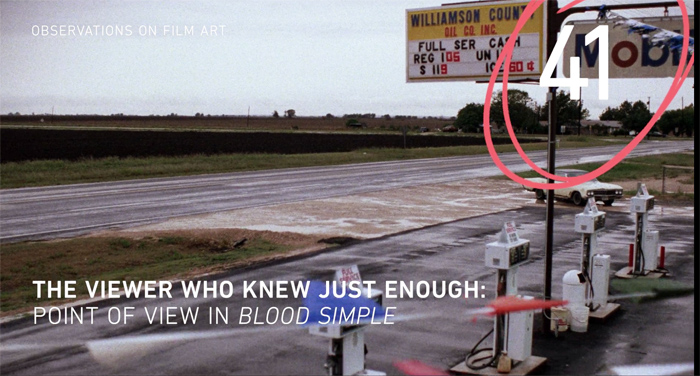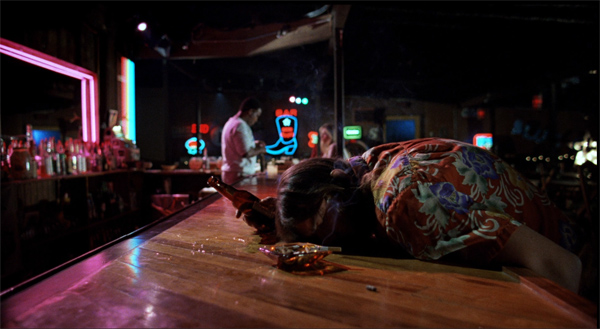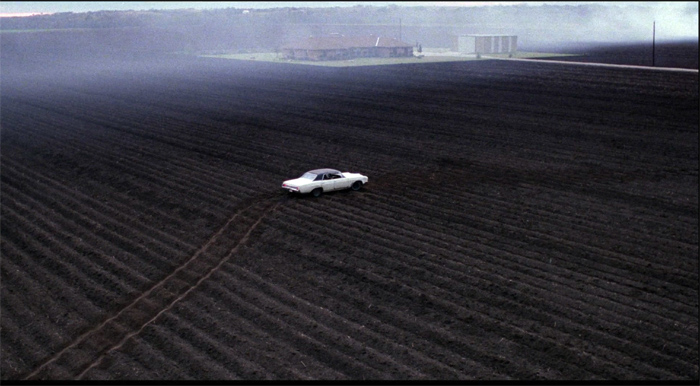Archive for the 'Narrative: Suspense' Category
Enter Benoît Blanc: KNIVES OUT as murder mystery
Knives Out (2019).
DB here:
Now that a sequel, Glass Onion, has been announced for the Toronto International Film Festival, it seems a good time to look back at Rian Johnson’s first whodunit Knives Out. The effort has a special appeal for me because it chimes well with arguments I make in Perplexing Plots: Popular Storytelling and the Poetics of Murder.
I don’t analyze Knives Out in the book, but it would have fitted in nicely. The movie exemplifies one of the major traditions I study, the classic Golden Age puzzle, and it shows how the conventions of that can be shrewdly adapted to film and to the tastes of modern viewers. In addition, Johnson’s film supports my point that the narrative strategies of “Complex Storytelling” have become widely available to viewers, especially when those strategies are adjusted to the demands of popular genres. Historically, such strategies became user-friendly, I maintain, partly because of the ingenuity demanded by mystery plotting.
Needless to say, spoilers loom ahead.
Revisiting and revising
The prototypical puzzle mysteries are associated with Anglo-American novels of the 1920s-1940s, the “Golden Age” ruled by talents such as Dorothy L. Sayers, Anthony Berkeley Cox, John Dickson Carr, Ngaio Marsh, Ellery Queen, and many others–supremely by Dame Agatha Christie. Similar books are still written today, often under the guise of “cozies” because they supposedly offer the comforting warmth of familiarity. Golden Age plotting flourishes in television too, in all those (largely British) shows about murder in supposedly humdrum villages.
Knives Out relies on Golden Age conventions from top to bottom. A rich, odious family is overseen by a domineering patriarch, mystery novelist Harlan Thrombey. When he’s found dead in his mansion, apparently of suicide, his family members become nervous because each has a guilty secret. The conflicts are brought into focus when it’s revealed that Harlan changed his will so as to disinherit all his offspring. He leaves his fortune and his house to Marta Cabrera, the nurse who administered his medications and became his friend and confidant. Is there foul play? Investigating the case are are two policemen and the private investigator Benoît Blanc. They must decide whether Harlan’s apparent suicide is actually murder and if so, who’s the culprit.
Johnson organizes his plot around many classic techniques. In the Golden Age, writers tended to fill the action out to book length by adding more crimes, such as blackmail schemes or a series of murders. Both of these devices are exploited in Knives Out. Marta is apparently the target of an extortioner, and the family housekeeper Fran is the victim of a poisoner. The film also employs the least-likely-suspect convention (a favorite of Christie’s) and a false solution (another way to fill out a book). Johnson supplies traditional set-pieces as well: the discovery of the body, a string of interrogations of the suspects, the assembling of suspects to hear the will read, and a denouement in which the master sleuth announces the solution by recapitulating how the crime was committed.
The conventions are updated in ways both familiar and fresh. The sprightly music and the flamboyant bric-à-brac of Harlan’s mansion deliberately recall Sleuth (1972), another reflexive, slightly campy revisiting of murder conventions. Johnson wanted to evoke the all-star, well-upholstered adaptations of Christie novels like Murder on the Orient Express (1974, 2017) and Death on the Nile (1978, 2022). But he has courted younger audiences with citations (the title is borrowed from Radiohead) and social commentary, such as references to Trump, neo-Nazis, and illegal immigration. The Thrombey clan’s inability to remember what country Marta came from reminds us of something not usually acknowledged about Golden Age classics: they often provided satire and social critique of inequities in contemporary society. (In the book I discuss Sayers’ Murder Must Advertise as an example.)
Like earlier Christie adaptations, Johnson’s film has recourse to flashbacks illustrating how the crime was actually committed. In Benoît Blanc’s reconstruction of the murder scheme, rapidly cut shots illustrate how the family black sheep Ransom sought to kill Harlan by switching the contents of his medicine vials, which would make Marta the old man’s murderer. But her expertise as a nurse unconsciously led her to switch the vials again, so she didn’t administer a fatal dose. This forced Ransom to continually revise his scheme, chiefly by destroying evidence of Marta’s innocence and trying to murder Fran, who suspected what he had done.
All of this is carried by the now-familiar tactic of crosscutting Blanc’s solution with shots of Ransom’s efforts, guided by Blanc’s voice-over. At some moments, the alternation of past and present is very percussive, with echoing dialogue (“You’re not gonna give up that,” “You’ve come this far”). For modern audiences, this swift audio-visual revelation of the “hidden story” is far more dynamic than a purely verbal recitation like that on the printed page.
Johnson tries for a more virtuoso revision of a classic convention in treating the standard interrogation of the suspects. Lieutenant Elliott’s questioning, followed by questions posed by Blanc, consumes an astonishing sixteen minutes of screen time. Such a lump of exposition could have been dull. But the accounts provided by Harlan’s daughter Linda, her husband Richard, Harlan’s son Walt, his daughter-in-law Joni, and Joni’s daughter Meg are brought to life by flashbacks to the day of Harlan’s death. Aided by voice-over, we get a sharp sense of each character’s personality while the mechanics of who-was-where-when during the birthday party are spelled out. Some flashbacks are replayed in order to alert us to disparities in the stories, which stir curiosity and set up further lines of inquiry. The technique isn’t utterly new, though; in the book I show that such shifts across viewpoints emerged in mystery films from the 1910s onward.
The pace picks up when, instead of sticking to one-by-one witness accounts, Johnson starts to intercut them, showing varied responses to the same questions.
The editing creates a conversation among the witnesses, as one disputes the testimony of another. This freedom of narration, mixing different accounts in a fluid montage, plays to modern viewers’ abilities to follow fast, time-shifting narratives.
The use of voice-over to steer us through the flashbacks takes on new force when Elliott and Blanc question Marta. Her account of the fatal night is given not as testimony but as her memory. She recalls tending to Harlan after the party, starting a game of Go with him, and then discovering that apparently she gave him a lethal dose of morphine. She’s distraught, but he consoles her and instructs her in how to cover up her mistake. His scheme, which involves an elaborate disguise and a secret return to his bedroom, is designed to give Marta an alibi by showing her apparently leaving before he dies.
In her memory Harlan’s voice-over narrates her flashback as she executes his plan. But she doesn’t confess to Elliott and Blanc. Following Harlan’s instructions, Marta lies to exonerate herself. Her propensity to vomit when she tells a lie drives her to the commode, but the police don’t notice. She has apparently fooled Blanc, who considers that her account “sounds about right.”
In such ways Johnson retools scenes of the police interrogation for contemporary viewers. But he goes further in revising Golden Age tradition. Well aware of the tendency of the puzzle plot to indulge in plodding clue-tracing, he provides a deeper emotional appeal.
Immigrants get the job done
The Golden Age plot relies on an investigation, the scrutiny of the circumstances leading up to and following a mysterious crime, usually murder. Plotting came to be considered a purely logical game, a matter of appraising motives, checking timetables, pondering clues, testing alibis, and eventually arriving at the only possible solution. These conventions were canonized in books like Carolyn Wells’ Technique of the Mystery Story (1913) and in many writings by authors. But some writers recognized that the emphasis on a puzzle tended to eliminate emotion and promote a boring linearity in which the detective poked around a crime scene and questioned suspects one by one.
Authors sought ways to humanize the investigation plot. Sayers filled it out with romance, social commentary, and regional color. Hardboiled novelists like Hammett and Chandler, who relied on many Golden Age conventions, turned the investigation into an urban adventure, with the threat of danger looming over the private detective. Others tried to blend in elements of the psychological suspense novel, as Nicholas Blake does in The Beast Must Die (1938), which traces how a bereaved father searches for the hit-and-run driver who killed his son.
Rian Johnson tries something similar in Knives Out. Into the investigation of Blanc and the police, he inserts a woman-in-peril plot. Although we’re introduced to Marta early in the film, she’s pushed aside for about half an hour as the inquiry takes over in the interrogation sequences I’ve mentioned. Then Blanc takes a kindly interest in her and probes her knowledge of Harlan’s attitude toward his family. And then, after Lieutenant Elliott becomes convinced that it’s a suicide, Marta is questioned. At this point, she comes to the center of the film and becomes its sympathetic protagonist and central viewpoint character.
Her memory episodes reveal that she believes she accidentally killed Harlan. But out of self-preservation and obedience to his orders, she doesn’t confess. She tries to ease away from Blanc, but he asks her to be his “Watson.” The rest of the plot forces her to accompany the investigation. Panicked that her scheme will be revealed, she often tries to suppress evidence: futzing up surveillance footage, traipsing over the muddy footprints she left, trying to throw away a piece of siding that she dislodged that night. Marta’s situation recalls that in The Woman in the Window (1944) and The Accused (1949), and in the TV series Columbo, in which guilty protagonists must watch as their trail is exposed.
Marta’s only ally appears to be Ransom, Harlan’s ne’er-do-well grandson. He justifies his concern as partly selfish: If she gets away with it, she can share Harlan’s legacy with him. As in many domestic thrillers, this handsome helper is also a little sinister, but Marta accepts his advice for how to respond to an anonymous threat of blackmail. When Marta discovers that someone has nearly killed the housekeeper Fran, she vows to confess. By then, however, Blanc has solved the mystery and absolved her of guilt.
Johnson deliberately made Marta a center of sympathy as a way of humanizing the investigation.
Very early on in the game I wanted to relieve the audience of the burden of “Can we figure this out?”. . . . I don’t think that’s a very strong narrative engine to drive things. I think that’s very intellectual and that clue-gathering–after a while you recognize “No, I’m not gonna figure this out,” so you kind of sit back on your hands and wait for the detective to figure it out. . . .
So the notion of tipping the hand early and giving this false but very convincing picture from Marta’s perspective of “I’ve done this and I’m in a lot of trouble.” . . . Could we do that so you’re genuinely on the side of the killer?. . . Once you’ve done that it’s very interesting because of the mechanics of the murder mystery, the fact that you know the detective always catches the killer. . . . The looming threat is that we know how mysteries work and we know that the detective catches [the killer] at the end. And we’re worried for Marta. We’re worried, “How is she possibly going to get out of this situation?”
Johnson uses several other tactics to put us on Marta’s side. While the performances of the actors playing the Thrombeys leans toward grotesquerie, Ana de Armas plays Marta more naturalistically. In time-honored Hollywood fashion, Johnson also makes Marta ill-treated. She’s dominated by the family who pretends to love her, and as an immigrant she’s in danger of seeing her mother deported. When she is named Harlan’s heir, the family descends on her like predators. In the end, as in many psychological thrillers, the woman in peril turns into a resourceful combatant. She bluffs Ransom into confessing his scheme, and only when she vomits on him does he realize she’s fooled him with a lie. We can enjoy the innocent trapping the guilty.
The game’s afoot. Which one?
The Golden Age story is more than a puzzle. It’s posited as a game. Of course the murderer is at odds with the detective, with each trying to outwit the other. At another level, the game is a battle of wits between author and reader. John Dickson Carr sums it up.
It is a hoodwinking contest, a duel between author and reader. “I dare you,” says the reader, “to produce a solution which I can’t anticipate.” “Right!” says the author, chuckling over the consciousness of some new and legitimate dirty trick concealed up his sleeve. And then they are at it—pull-devil, pull-murderer—with the reader alert for every dropped clue, every betraying speech, every contradiction that may mean guilt.
Golden Age authors realized that the core mystery could be enhanced by techniques that both mislead the reader and drop hints about what’s really going on. The cultivated reader became alert not just for characters who might lie but for narration that was engineered to be misunderstood. Golden Age authors weaponized, we might say, every literary device to steer the reader away from the solution. The trick was to do this without cheating.
If this genre is a game, then, following sturdy British tradition, “fair play” becomes the watchword. Earlier detective writers, notably Conan Doyle, did not feel obliged to share all relevant information with the reader. The master sleuth was likely to discover a clue or a piece of background knowledge that he or she kept quiet, the better to flourish it in triumph at the denouement. Instead, Golden Age authors made a show of telling everything.
The concept of fair play was made explicit in Ellery Queen’s novels, which included a climactic “challenge to the reader” explaining that at this point all the information necessary to the solution was now available. (This device was replicated in the EQ TV series.) Even without this pause in the narration, Golden Age writers were careful to supply everything before the big reveal.
Knives Out is very much in the game tradition. It knowingly follows self-conscious “meta”-mystery films like Sleuth, The Last of Sheila (1973), and Deathtrap (1982), all of which flamboyantly exploit classic conventions (often with crime writers at the center of the plot). Accordingly, Johnson is aware of the need to play fair.
A straightforward example occurs in the interrogation sequence. Members of the Thrombey family tell Blanc and the police that Harlan’s last day with the family was a happy occasion. But the flashbacks reveal to us that they’re lying. We see Harlan fire Walt as his publisher, confront Richard with his infidelity, and cut off Joni’s funding for Meg’s tuition. Soon enough Blanc will intuit their deceptions and ask Marta for confirmation, but the flashbacks make sure we grasp their possible motives for killing Harlan.
But telling everything required telling some of it in deceptive ways. Otherwise, there’d be no puzzle. The craft of Golden Age fiction demanded skillfully planting crucial information that can be (a) recalled at propitious moments by the detective but (b) neglected by the reader (“I should have noticed that!”). Perplexing Plots traces various stratagems for achieving how authors muffled crucial information through ellipsis, distraction, and other tactics.
Consider Fran’s dying message. As Marta bends over her, Fran gasps, “You did this.” Since we’ve been led to believe that Fran is blackmailing Marta, it seems to confirm that she’s got proof of Marta’s guilt in the toxicology report. But the dying message turns out to be equivocal. Fran is actually saying, “Hugh did this”–identifying her would-be killer. Huh?
Early in the film when Ransom comes to the mansion, the police greet him as “Hugh Drysdale,” to which he replies, “Call me Ransom. Ransom is my middle name. Only the help calls me Hugh.” Fair play, but given to us in a distracting way. The line is played down: Ransom delivers it quickly as he’s turned from the camera and strides into the house, and the policemen’s reactions are more prominent in the shot.
To play fair, Johnson reiterates the name just before the revelation, when Blanc addresses him as “Mr. Hugh Ransom Drysdale.” Since in Fran’s scene we can’t tell the difference between “You” and “Hugh,” file this under Carr’s category of “legitimate dirty trick.”
As a result, anything can become a clue for interpretation/misinterpretation. But for Golden Age creators, authorial craft isn’t only a matter of producing clues. Clues are available to the investigators and are crucial to the solution. But at the same time the author can supply hints in the narration, addressed to us behind the backs of the characters. An instance in Knives Out is the title of one of Harlan’s books, glimpsed in a montage of his bookshelves. In a film reliant on syringes, The Needle Game would seem to be a tip-off.
Or a hint can become a clue eventually. After Marta’s wild night covering up her “crime,” she rushes home and takes refuge in front of the TV. As she nervously taps her foot, a close-up reveals a single bloodstain on her sneaker.
She’s unaware of it, but the stain opens the possibility that it could incriminate her later. The film lets us forget it until the very end, when Blanc says he knew she was involved in Harlan’s death from the start, when he spotted the bloodstain. The hint for us became a clue for him.
Golden Age plotting invites attention to minutiae of presentation. Although Agatha Christie is sometimes condemned as a clumsy writer, Perplexing Plots tries to show that she often mobilizes a flat style to mislead us. Similarly, the attentive viewer will notice little felicities in Knives Out. For instance, when we first see Marta return to the mansion through the forest path, a shot shows her leaving the tracks she’ll later try to smear over. But in Blanc’s reconstruction, we see Ransom returning to the mansion by balancing on the wall lining the path, so as to leave no traces in the mud.
Had Ransom walked on the path, Johnson would have been besieged by Twitter complaints.
All this is a matter of self-conscious artifice. As Johnson notes, few readers take seriously the task of solving the mystery themselves. One member of the Ellery Queen collaboration admitted: “We are fair to the reader only if he is a genius.” The fair-play convention is at once a pretext for the display of authorial ingenuity and a source of artistic power–proof that a plot can harbor a hidden intricacy unsuspected by the reader. One dimension of connoisseurship in the classic mystery is the reader’s admiration of artifice, a taste for elaborate construction. If it’s all in the game, then we’re no longer committed to mundane realism. A portrait can whimsically change from scene to scene.
Henry James argued for a through-composed form of the novel, where every detail was carefully judged for its effect and its balance with others. An unexpected legacy of Jamesian formalism, I think, was the Golden Age authors’ ambition to make each story a tour de force, a test of readers’ skills and a revelation of unexpected resources in storytelling technique. Mystery stories are ingenious, as Ben Hecht noted, because they have to be.
The film’s rapid pace, time-shifting, and looping replays exemplify current tastes for what’s been called Complex Storytelling. But one task of my book is to suggest that popular storytelling has been complex for quite a while. The techniques have become refined and revised, and their appeal has been sharpened by emerging audiences (e.g., in the 1990s) and new technologies (e.g., video that allows replays).
We were sensitized to these techniques by mystery fiction throughout the century. The play with incompatible viewpoints, reruns of action bearing new significance, the strategic use of ellipsis–all are there in the Golden Age tradition. Likewise, the notion of fair play persists in all those “twist” films that flash back to show us actions that take on a new significance. Golden Age strategies, and mystery plotting more generally, have prepared audiences to expect pleasurable but “fair” deception in all genres. Knives Out, among other accomplishments, helps us understand how today’s sidewinding stories have roots in a genre that’s too often dismissed as mere diversion.
The quotations from Rian Johnson come from the Blu-ray supplement to Knives Out, “Planning the Perfect Murder,” between 2:21 and 4:20. The supplementary material on the disc is exceptionally detailed and reveals Johnson’s keen knowledge of the history of mystery fiction and film.
Exceptional studies of Golden Age mysteries are LeRoy Lad Panek’s Watteau’s Shepherds: The Detective Novel in Britain (1979) and Martin Edwards’ Golden Age of Murder (2016), The Story of Classic Crime in 100 Books (2017), and The Life of Crime: Detecting the History of Mysteries and Their Creators (2022). See also Mike Grost’s encyclopedic site A Guide to Classic Mystery and Detection.
For another good example of Golden Age misdirection appropriated in cinema, see this entry on Mildred Pierce.
Perplexing Plots is available for pre-order here and here. This is a good place to thank Sarah Weinman and Yuri Tsivian for their favorable comments on the book, which are available on these sites.
P.S. 9 August: I now realize I neglected to mention that Joni’s daughter Meg isn’t as harshly characterized as the rest of the Thrombey clan. She’s a friend to Marta and Fran and seems genuinely to care about Marta’s fate. However, she’s still a pothead who walks out of her benefactor’s birthday party and who colludes with the family to call Marta to get information. In plot terms, she’s one more threat to Marta.
Although we didn’t discuss this point, I thank John Toner of Renew Theaters for amiable correspondence about Knives Out.
Knives Out (2019).
PERPLEXING PLOTS: On the horizon
DB here:
In the Before Times, I didn’t watch much fictional TV. Our modest monitor was chiefly a delivery device for news, DVDs, and Turner Classic Movies. We followed The Simpsons, and I came to like Deadwood and Justified, but usually the time commitment demanded by long-form series put me off. I gave my curmudgeonly reasons long ago on a blog entry.
But over the last nine months, forced to stay home, I dipped my toe in the water. Streaming made it easy to catch up with shows I’d never seen and offered a plethora, or rather a glut, of original series. This still-limited experience of long-form shows confirms the presence, if not the dominance, of what Jason Mittell in his excellent book calls Complex TV.
Many shows mix timelines with abandon. Both the documentary WeWork; or, The Making and Breaking of a $47 Billion Unicorn (2021) and the docudrama WeCrashed (2022) open near the end of the story action and then flash back to show what led up to it. (This crisis structure became especially common in 1940s Hollywood.) Billions, an older series I’d never followed, contains an episode (Season 2, 2016) that jumps to and fro among a funeral, scenes taking place before it, and scenes afterward, several attached to different characters. In the Hulu series Dopesick (2021) a sliding timeline graphic shifts among many periods and character viewpoints; to keep track of it all you’d need to make a spreadsheet. (It would amount to something like the whiteboard used in writers’ conference rooms to map out the unfolding series.) I can’t recall all the shows that friends have recommended as examples of daring play with narrative.
Of course all this isn’t news. For years both indie films and Hollywood blockbusters have offered complicated segmentations, broken timelines, and splintered viewpoints, with contradictory replays and unreliable narration. Still, it was good to be reminded that the problem I’m tackling in my latest book is still current—indeed, dominant. We may have to wait for the new Justified series to see a return to straightforward linear storytelling.
When and how did viewers develop the skills that lets them appreciate the New Narrative Complexity? This is at the center of Perplexing Plots: Popular Narrative and the Poetics of Murder.
Maybe we were always smart
Intolerance (1916).
There’s a view, most eloquently posed by Steven Johnson in Everything Bad Is Good for You, that these comprehension skills are a fairly recent development. They stem from rising IQ levels, growing facility with video games, and other cultural phenomena after the 1970s. People are now smarter consumers of narrative than they were in the days of I Love Lucy.
I argue instead that popular narrative has been cultivating these skills across a much longer period, and they firmly took hold in mass culture at the start of the twentieth century. You can get a summary of my argument here on the Columbia University Press site.
Most broadly, a lot of (now-forgotten) mainstream plays and novels were as experimental in shifting point-of-view and juggling time frames as any we find today. For example, we celebrate backwards stories as typical of the demands of modern storytelling. The play and film Betrayal and the films Memento and Shimmer Lake are among many recent media products presenting the scenes in 3-2-1 order. But this possibility was discussed by a prominent critic in 1914, and soon a major woman actor wrote a play that used reverse chronology. There followed other examples, not least W. R. Burnett’s novel Goodbye to the Past (1934) and the Kaufman and Hart play Merrily We Roll Along (1934).
Some will argue that innovations of popular narrative are dumbed-down borrowings from modernist or avant-garde trends. I try to show this process as a two-way dynamic: modernism borrowing from popular forms, mainstream storytellers making modernist techniques more accessible. But we also find that popular storytelling has its own intrinsic sources of innovation, as with the reverse-chronology tale and Griffith’s application of crosscutting to different time frames in Intolerance (1916).
So it seems to me that audiences have long been capable of tracking the sort of fancy narrative devices we find now. They encountered them in many types of stories, and I devote the first part of Perplexing Plots to a quick survey of developments in novels and plays. (Yes, Stephen Sondheim is involved.) Audiences have learned to enjoy self-conscious artistry, an awareness of form and technique–what one disapproving reviewer of Wilkie Collins called “the taste of the construction.”
Such a taste was cultivated in depth in one mega-genre. That was a major training ground for giving us the skills to follow complex, sometimes deceptive storytelling.
Mystery on my mind
Pulp Fiction (1994).
Ever since my teenage years I’ve been a fan of mysteries on the page and on the screen. I’ve smuggled discussions of detective stories and crime thrillers into many of my books, and my last one, on 1940s Hollywood, did a lot with this form of storytelling–largely because it was so central to the films of that era.
Perplexing Plots in a way turns Reinventing Hollywood inside out. The earlier book put movies at the center while showing how filmmakers borrowed from mysteries in other media. The new one puts fiction, theatre, radio, and even comic books at the center, discussing how mystery conventions developed–and showed up in films as well. The two books complement each other, I guess, although the historical sweep of the new one runs from the 1910s to the present.
Mystery was essential to many classic novels, from Wuthering Heights to the tales of Henry James and Joseph Conrad. Dickens and Wilkie Collins made mystery a major attraction of “sensation fiction.” In the twentieth century, the Anglo-American whodunit, the suspense thriller, and the hardboiled detective tale–to take the three most well-known genres–trained audiences in appreciation of nonlinear plotting, misleading narration, and subterfuges of concealment.
A Western or a science-fiction tale may include a mystery, but it doesn’t have to. In mystery fiction, the suppression and misinterpretation of information is foundational to the genre itself. A mystery depends on a “hidden story,” which will often be revealed out of chronological order and refracted through the minds of several characters. At a meta-level, the genre cultivates a gamelike approach, where we expect the author to give with one hand and take away with the other. Across history, a mass audience became sophisticated consumers of complex narratives.
I trace how this happened with Agatha Christie, John Dickson Carr, Marie Belloc Lowndes, E. C. Bentley, Dashiell Hammett, Raymond Chandler, Daphne du Maurier, Cornell Woolrich, and many other authors. I spend a lot of time analyzing both plot structure and the texture of the writing. If nothing else, I hope to show that this genre encourages not only great ingenuity in plotting but also subterfuges of style.
I trace this process into the 1940s, when in my view the basics of contemporary techniques crystallized and become widespread. The book then looks at some case studies of how crime novels and films have explored the various possibilities of broken timelines, disparate viewpoints, and misleading narration. I devote chapters to Erle Stanley Gardner, Rex Stout, Patricia Highsmith, Ed McBain, Donald Westlake, Quentin Tarantino, and Gillian Flynn.
I could have gone much farther. Every reader will have a long list of authors I’ve omitted. But I had to stop somewhere! And I decided to concentrate on some of my favorites. The result is, if nothing else, appreciations of the verbal artistry of some underestimated storytellers.
This isn’t to say that audiences of 1920 could have easily followed Inception (2010) or Everything Everywhere All At Once (2022). Storytellers have pushed forward, revising schemas that are widely known and teaching us to recognize the tweaks they’ve introduced. Audiences have accumulated a repertory of skills, built upon their experiences of other formal experiments. Those experiences, I want to show, have been crucially shaped by the conventions of mystery narratives.
Looking back on other things I’ve written, I find that I’m repeatedly concerned with finding beauty in popular genres and modes of storytelling. My studies of Hollywood, Hong Kong cinema, Japanese films, and other forms of cinema have taught me that mass entertainment harbors not only pleasures but also precise craft and daring artistry. While I’ll never give up my love of disruptive and “difficult” work, I find that films appealing to wide audiences, from His Girl Friday and Meet Me in St. Louis to the masterworks of Ozu and Hitchcock and Lang, have a unique power. Fortunately, we don’t have to choose.We can have them all. Perplexing Plots is my effort to show that storytelling craft in its humblest forms can yield its own rapture.
Advance appraisals of the book can be found here. (Click on “Reviews.”) It’s due to be published in January 2023. In the months ahead, from time to time I hope to blog more about the ideas in the book. In the meantime, I wait for the new installment of Slow Horses.
There are too many people to thank here; my debts are recorded in the book’s Acknowledgments. But at least I want to thank John Belton for supporting the project, and Philip Leventhal and Monique Briones at Columbia University Press for their swift and efficient work on the manuscript. And love to Kristin, who took care of me while I finished the book and recuperated from surgery.
The Lady Vanishes (1938).
KIMI: She’s here
Kimi (2022).
DB here:
Just when I worried that the solitary-woman-in-peril cycle had ended, along comes Steven Soderbergh’s Kimi on HBO Plus. Following on the fine No Sudden Move from last year, his latest effort shows how an imaginative script (from Friend of the Blog David Koepp), elegant direction, an unpredictable score, and an engagingly eccentric central performance (from Zoë Kravitz) can revivify some classic conventions.
Some critics think that when parodies show up, the genre is on the downturn. The streaming release of The Woman in the House Across the Street from the Girl in the Window (2022) might suggest that the cycle based on The Girl on the Train (2016) and The Woman in the Window (2021) had run its course. But actually, parodies can show up at any point in the life cycle of a genre. The Great K & A Train Robbery (1925) didn’t kill off the western, and Spaceballs (1987) didn’t wipe out space opera. So it’s good to know that the presence of Woman in the House Across the Street etc. doesn’t make a straightforward but sophisticated entry like Kimi any the less sparkling.
It depends on what I’ve called the Eyewitness Plot, and I’ve tried in Revisiting Hollywood to show how that emerged from the flurry of creative activity we find in 1940s studio cinema. Here the protagonist sees what may be a crime and asks the authorities to intervene. There’s enough uncertainty about the incident itself, and about the reliability of the witness, to make the police doubt that there’s been a crime. So the protagonist has to investigate–while becoming a target of violence in turn. Rear Window (1954) is the standard example, but it has many predecessors in fiction, film, and radio, notably The Window (1949). A variant relies not on sight but sound: the protagonist hears something of criminal consequence. That alternative is played out in Sorry, Wrong Number (1948) and, later, The Conversation (1974) and Blow-Out (1981).
Koepp and Soderbergh, both connoisseurs of classic Hollywood, understand the power of locking us into the perceptions of the witness while at the same time keeping us aware of the larger context of the action. Rear Window is exceptionally strict in limiting us to what Jeff sees and hears, but even then there is a telltale moment when we’re given information that would seem to contradict his belief that his neighbor has murdered his wife. More common is a balanced narrration that ties us to what the protagonist knows but occasionally strays away to supply backstory and ancillary information–usually, just enough to foster suspense.
That’s enough setup. Major spoilers follow! If you haven’t seen Kimi yet, visit and return.
She looks and listens
Angela Childs lives in lockdown. Not just the pandemic but a traumatic sexual assault has made her afraid to leave her Seattle loft, and more basically resistant to emotional contact. She works from home for Amygdala, a company promoting an Alexa/Siri gadget called Kimi. Unlike the competitors, which rely on machine learning, Amygdala has an army of monitors that track actual user dialogues with Kimi in order to correct its errors. Angela is a monitor, and on one recording she hears, muffled by music and noise, what seems to be a murder. After cleaning up a dense recording and inducing a more experienced hacker to find the user’s entire log of Kimi conversations, Angela discovers a crucial one that seems to lead up to the crime.
Here the official reluctance to believe the witness takes the form of an Amygdala executive’s demand to listen to the recording. When Angela insists that the FBI be present for the playback, the corporation takes steps to silence her. The second large section of the film consists of a prolonged chase and, back in her loft, a final confrontation with the men who committed the crime.
The film’s opening establishes, as a sort of intrinsic norm, the alternation between the wider view of the crime’s circumstances and Angela’s limited perspective. The first scene sets up Bradley Hasling awaiting Amygdala’s IPO, but worried because he’s paying off someone for suppressing information about an unnamed woman.
With our curiosity aroused, the plot can afford to introduce us to Angela and her routines in a more leisurely way. Without the Hasling scene, this stretch would be mostly character portrayal, but it gains keener interest as we must wonder how Angela’s fate will intersect with his. Glimpses of Angela fussily making her bed, brushing her teeth, and exercising on her bike also serve to illustrate how she activates Kimi for music and for computer access.
Just as important are the passages of optical POV that show her at her window scanning her street. She looks across at a family in the building opposite, and then looks up and to her left, where she sees the bearded man we’ll learn is called Kevin. He looks back at her.
She swivels her gaze to another window opposite and sees a closed curtain.
Later on the balcony she looks at the window and this time sees Terry, her casual lover, getting ready for work.
She texts him, and after an external, objective pan shot links the two buildings, she asks Terry if he wants to join her for a breakfast at the food truck down below.
However, she’s afraid to leave the apartment, and her fractured activity is rendered in discordant POV angles. After a shot of her in the shower, we see Terry at the truck, from her usual station point. There’s no lead-in shot of her looking; is she watching from offscreen after the shower, or has the narration worked behind her back, while reminding us of her usual position?
Finally, when she collapses on the floor, unable to leave, we get the same high angle on Terry at the truck, texting her and looking up.
Cut back to her still on the floor. The narration is now operating independent of her vision, but with traces of her viewpoint lingering.
The passage is capped by a shot of her at the window looking down, followed by an optical POV of the food truck, sans Terry.
Another shot of her seals the sequence, but when she pulls away from the window, we get an extra, new angle on her: from outside and above. It’s a fair approximation of what Kevin’s viewpoint on her might be. Yet there’s no shot showing him watching.
The “unclaimed” POV shots that close this scene acknowledge that however much we’re tied to the protagonist’s perceptions, the narration won’t limit us to them–that there is wiggle room to supply extra information, and to imply that our heroine is watched by others. This fluctuating access will become important in the crosscutting that provides the film’s climax.
She flees and fights
The fusion of external viewpoints and subjective ones continues in different ways later. When Angela plays the recordings of the attack, Soderbergh gives us her mental imagery–first as blurred cutaways, then as superimpositions. She’s imagining the assault. Later we’ll learn she has been a rape victim herself.
We’ll later discover that the faces of the murderers are those of the thugs who will pursue her. Yet she hasn’t seen them yet, so she can’t plausibly be visualizing them in the scene.
This is an innovation, I think. In the Forties and since, if these visualized images were to accompany the playback, the faces of the killers would have been indiscernible. Soderbergh is willing to violate plausibility in order to gain economy (introducing us to the thugs) and to continue his initial strategy of rendering subjective experience while also adding information for us.
A milder version of the tactic will be used in the climax, after Angela is captured and lying semi-unconscious in the van. We see her awake and apparently listening to the thugs’ dialogue, while superimpositions suggest the passage of the van through the neighborhood.
Incidentally, these are good examples of the persistence of “Impressionist” cinema techniques from the silent era. Soderbergh had made use of them in Unsane (2018), another film about a woman in peril.
Apart from the prologue showing Hasling’s phone call, the film’s first stretch is confined to Angela’s loft. It’s a classic “bottle” situation, a premise that Koepp is fond of. (Cf. his script for Panic Room, 2002.) It’s Angela’s sympathy for the victim of the crime that propels her out of her bubble into the wider world. Here Zoë Kravitz’s performance takes on a new dimension.
In her loft she’s clipped and brusque, dominating everyone she talks to. Her vulnerability, though, is suggested by her obsessive hand sanitizing. Emphasized by her waving her hands to dry them, it becomes practically a nervous tic.
Once outside, she scoots along, arms jammed to her side, head buried in her hoodie, and body as stiff as Max Schreck’s. She tries to be as locked-in outdoors as she is indoors.
Soderberg compensates for her rigidity with camera technique that’s liberated from the confines of her loft. As Manohla Dargis points out in her review, now the film becomes a procession of canted angles and hurtling camera moves, swooping around her and trying to keep up.
Once back in the loft, however, the framing gets poised again and we’re subjected to a precise exercise in suspense. Close-ups and abrupt changes of angle provide exactly what we need to see at each instant.
And things planted quietly in the opening, particularly Angela’s knowledge of building construction, become crucial to her survival. Kimi proves to be a lifesaving sidekick, proving Hitchcock’s dictum concerning Jeff’s use of flashbulbs to save himself in Rear Window: you should use everything you’ve put into your scene.
One nice felicity: You might expect that Terry would turn out to be the “helper male” of so many women-in-peril plots (e.g., the Joseph Cotten character in Gaslight, 1944). Prototypically, this character rescues the protagonist and provides romantic interest for the future. Koepp’s screenplay shrewdly sets Terry up for this role when Angela looks outside during the gang’s siege and sees Terry’s apartment empty.
Later Terry is shown in a street-level, objective shot, walking to Angela’s building. This violation of the intrinsic POV norm suggests an impending rescue. But that prospect is canceled when he stops as if remembering something and turns back.
He does arrive, but too late to help. Terry’s expression as Angela calls 911 is a perfect capstone for the scene. The same wit flashes out of the epilogue, which suggests she’s broken out of her shell, but she still prudently uses sanitizer.
The domestic suspense thriller focused on a female protagonist remains a popular genre of novels. I devoted a chapter to it in my forthcoming book Perplexing Plots: Popular Storytelling and the Poetics of Murder. There haven’t been many film adaptations of them since The Woman in the Window, but maybe the neo-Gothic The Girl Before (2021) will unleash more. In the meantime, I’m glad that Koepp and Soderbergh have found ways to give the conventions brisk new life.
David Koepp remarks: “You’re right about the lingering effect of 40s cinema, as you and I have discussed many times. I’d say Sorry, Wrong Number was the direct antecedent here. . . I mean, the party line in Sorry, Wrong Number is basically the Alexa of its time, no?” Interesting in this connection is that the lengthy survey of Angela’s loft in the epilogue shows Kimi no longer there.
Another grace note: KT wondered if the precariously balanced kombucha bottle is psychologically revealing. It turns out to be the consummation of a moment from an earlier Koepp film.
The bottle on the edge of the counter — that was me making good on a setup I did in Secret Window, fifteen years ago. Seriously. There’s a shot in there where Johnny’s character, in a state of high anxiety and agitation, sets a glass down on his kitchen counter hastily, and doesn’t notice it’s only half on the counter. We did seventeen or twenty takes to get exactly the right gravity-defying balance on the edge. It was a pretty literal visual metaphor — you know, he’s on edge.
Thing was, in post-production I realized I had put in a perfect setup, but never paid it off. Why not have the glass fall and smash twenty minutes later, when we’re least expecting it?? Wished I had, never did.
So I used it again in Kimi, but with the (to my mind) required payoff, and at a moment of high tension. So, Angela, in her argument with Terry, is highly agitated, and smacks the bottle down on the counter carelessly, not realizing how close it is to the edge. (The KT hypothesis proves correct!) Angela forgets about it. So do we. Ten minutes later, when we’re all keyed up about something else, SMASH!
Thanks to David for corresponding.
The Hitchcock remark is this: “Here we have a photographer who uses his camera equipment to pry into the back yard, and when he defends himself he also uses his professional equipment, the flashbulbs. I make it a rule to exploit elements that are connected with a character or location. I would feel that I’d been remiss if I hadn’t made maximum use of those elements” (Truffaut/Hitchcock, rev. ed. 1983, 219).
Kimi (2022).
Let’s play God, imperfectly: BLOOD SIMPLE on the Criterion Channel
Blood Simple (1984).
DB here:
Over the last couple of years I’ve been writing a book on common strategies of popular storytelling in film and other media. I go on to trace how those strategies get worked out in detective stories and thrillers. If you follow this blog, you know that these genres are ones I enjoy and like studying.
So I was happy to offer as one installment of our Criterion Channel series, Observations on Film Art, a short analysis of storytelling strategies in Blood Simple. In it I suggest that although the film has the trappings of a neo-noir–the somewhat downmarket characters, the seedy milieu, the chiaroscuro lighting–in its narrative techniques it’s closer to a Hitchcock thriller. That’s because its manipulation of point of view, one of the resources of popular storytelling, is close to the “partial and misleading omniscience” of the thriller genre and Hitchcock’s narration in particular.
Put it another way. We aren’t restricted to what only one character knows, as in a detective story like The Big Sleep (1946). Instead, Blood Simple steers us selectively from one character to another. So we always know more than any one of them does. That creative choice increases suspense–knowing the dangers that lurk ahead–but it also summons up an ironic detachment from them, as we watch them make their foolish mistakes. In a word, if you know the film: fish. Here’s another: lighter.
This shifting viewpoint doesn’t give us absolute knowledge, though. There is still some information that slips through the cracks. So we can enjoy superior knowledge in long stretches, while still getting some sudden surprises, or even shocks. (Consider the climax with the perforated wall and the knife at the window.) In their first feature, the Coens prove themselves already fully in control of finely-tuned cinematic storytelling. We’re a step ahead of the characters, but the film is a step ahead of us.
The Coens are also aware of our pleasure in their control. The characteristic Coen awareness, a sly recognition of letting the audience share their power over our access to the story world, is everywhere in evidence. I didn’t have time to mention the shot that everybody remembers, the tracking shot down the bar that simply lifts over the drunk sprawled on the bar top. We become aware of how the movie’s unfolding narration is absolutely ruling how we see this world, and the Coens make a gag out of it. Even the camera-god has a sense of humor.
If you have a chance to watch it, Jeff Smith, Kristin, and I hope you enjoy it–and, of course, the film, which is endlessly rewatchable.
As usual, thanks to the team at Criterion: Peter Becker, Kim Hendrickson, Penelope Bartlett, and their superb postproduction boffins. We recorded the commentary under Covid conditions, with the expert guidance of Erik Gunneson, Meg Hamel, and James Runde.
For more on the Coens’ mastery of storytelling technique, check out the analysis of their fine The Ballad of Buster Scruggs.
You can sample other blog entries on mysteries and thrillers in several entries, in particular our discussions of Hitchcock (of course), and the genre as a whole (here and here and here). An early version of one chapter of my book in progress is devoted to the great Rex Stout. Another chapter will revise what I said about Gone Girl. I also discuss Hollywood’s approach to crime and mysteries in the book Reinventing Hollywood: How 1940s Filmmakers Changed Movie Storytelling.
Blood Simple (1984).













